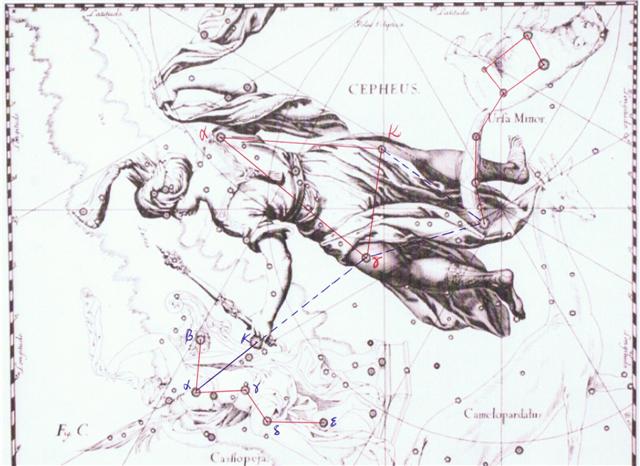King Cepheus is falling head down from his throne. In February 17 the bivalve shell (pure) has reached the end of its upper half after 14 lunar synodic months counted from January 1 the previous year.
The 10th Hindu lunar station explains 'Throne' at Regulus and the little King apparently comes to power by entering his 'throne' at 10h. Possibly the 22nd Hindu station, referring to Lyra, is expressing how once again the throne is left empty, because this is the only station with no comment:
The stars α, ε, and ζ Lyrae form a triangle with ε at the top, just as ε Cephei marks the top of the king's crown:
And ζ is below at the left corner of the triangle both in Cepheus and in Lyra, although by being an upside down constellation ε will be below ζ in Cepheus. Vega in Lyra corresponds not to α in Cepheus but to δ (Alrediph). Alderamin (α Cephei) is on the right shoulder of King Cepheus:
King Cepheus is perpetually 'falling on his face' as the Polynesians would say. He does not partake in the 'band of life' (the ecliptic path around Sun). His position is in the region of northern sky where the stars never go down at the horizon in the west, never 'dies'. This of course depends on the point of observation, because the latitude defines which stars are circumpolar. Indeed, Hevelius has put Polaris between King Cepheus' legs. I have drawn red lines for easier recognition of Cassiopeia (his Queen) and Ursa Minor, with Polaris at the end of the long tail of the little bear. It is not easy to identify the stars of Cepheus and only by drawing the dotted blue help lines could I find what star was at the left thigh of the king. Evidently Hevelius may have used a line from α Cassiopeia (Schedir) through κ Cassipiea (a star not yet in my list) towards Polaris and in between located Alrai (γ Cephei). Then κ Cephei (not in my star list) was symmetrically put at the right thigh of the king, forming an equilateral triangle with Alrai and Polaris. Notably King Cepheus has lost not only his throne but also handed over his ruler's staff to his Queen (at κ Cassiopeiai). The last star of Cepheus is κ, but I cannot say κ is the last star to rise. Instead the whole figure can be thought of as circumpolar and the rotation of the figure - as seen from the outside of the celestial globe - is righthanded (with little finger coming last). | |||||||||||||||||||||||||||||||||||||||||||||||||||||||||||||||||||||||||||||||||||||||




